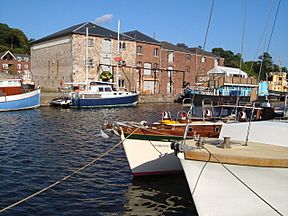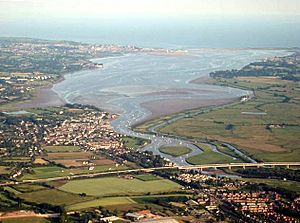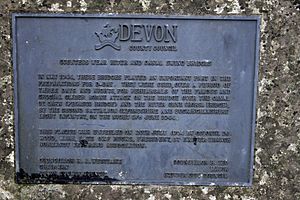Exeter Ship Canal facts for kids
Quick facts for kids Exeter Canal |
|
|---|---|

Boats moored in Exeter Canal basin
|
|
| Location | Beside the River Exe |
| Country | England |
| Specifications | |
| Lock length | 122 ft (37 m) |
| Lock width | 26.25 ft (8.00 m) |
| Geography | |
| Start point | River Exe |
| End point | Exeter Quay |
The Exeter Ship Canal, also known as the Exeter Canal, is a special waterway in Exeter, Devon, England. It runs next to the River Exe and leads to Exeter Quay. This canal is very old, built in the 1560s, long before many other canals in the UK. It's one of Britain's oldest man-made waterways!
Contents
The Exeter Canal: A Journey Through Time
For a long time, the River Exe was a busy pathway for ships coming right into Exeter. But then, around the 1270s, a powerful lady named Isabella de Fortibus, the Countess of Devon, built a weir (a kind of dam) across the river. This weir stopped ships from reaching Exeter and hurt the city's trade.
Early Challenges and Blockages
Later, in 1317, another powerful person, Hugh de Courtenay, 9th Earl of Devon, built another weir. He also built a new dock at Topsham. This meant ships had to unload at Topsham, and the Earls charged high fees to move goods to Exeter. For 250 years, Exeter tried to get the river opened again, but nothing worked.
Finally, in 1550, King Edward VI gave permission to reopen the river. However, by then, the river had become too shallow with mud and sand.
Building the First Canal
In 1563, traders from Exeter hired a man named John Trew to build a new canal. This canal would go around the weirs and connect back to the River Exe in the middle of Exeter. A new dock, or quay, would also be built there.
Work started in February 1564 and finished in late 1566 or early 1567. This canal was special because it had three pound locks. These were the first of their kind in Britain! They allowed boats up to 16 tonnes to pass through. The canal was about 3 feet (0.91 m) deep and 16 feet (4.9 m) wide. It stretched about one and three and a quarter miles (5.2 km) from just below Countess Wear to Exeter's city center.
However, this first canal wasn't perfect. Boats couldn't always enter it because of the tides. Also, moving goods twice over such a short distance made it more expensive than using roads. The weir that keeps the water level in the quay is still called "Trew's Weir" after John Trew.
Expanding and Improving the Canal
In 1677, the canal was made longer, and its entrance was moved further downstream to Topsham. Then, in 1701, the canal was made deeper and wider. This allowed bigger ships, even ocean-going ones, to use it. At the same time, the number of locks was reduced to just one. Special Floodgates were also added at the canal's entrance.
These improvements made the canal very successful for a long time. But its importance slowly faded as the wool trade declined in the 1800s. Later, the rise of railways also meant fewer ships used the canal.
There were many attempts to connect Exeter to the national canal and railway networks, but most failed. For example, a plan to link Exeter to Bristol by canal was never finished. Even when railways finally reached the canal basin in 1867, the canal was too small for the largest ocean-going ships.
The Canal in Modern Times
Even in 1939, the canal was still moving about 63,000 tons of goods each year. After World War II, people still saw it as a good way to transport things. There were plans to make Turf Lock, where the canal meets the river, deeper and bigger for ships up to 600 tons.
A D-Day Connection
In May 1944, the Countess Weir Road bridge (which is now part of the A379 road) was used for a very important rehearsal. Soldiers practiced for the D-Day attacks on bridges in France. A special plaque near the bridge remembers this event.
End of Commercial Use
One of the last regular commercial ships to use the canal was the tanker Esso Jersey. It delivered petrol until 1971. Commercial traffic mostly stopped after a ship unloaded timber in December 1973.
However, a ship called Countess Weir kept using the canal. It was built in 1963 to carry sewage sludge from Exeter's sewage works out to sea. It was later modified in 1975 to fit under the new M5 motorway bridge. This ship stopped dumping sludge at sea in 1998 and was sold.
Leisure and Redevelopment
As commercial use declined in the 1960s, more people started using the canal for fun. In the 1970s, the canal basin was even used for filming parts of the TV show The Onedin Line.
In 2002, the future of the canal looked brighter when the city basin was part of a big redevelopment plan. The quay area still has old buildings, but they are now used for new things like antique shops, cafes, restaurants, and studios. The canal basin is also a popular spot for water sports like canoeing, rowing, and kayaking.
A small, hand-powered passenger ferry called the Butts Ferry still operates across the river near Exeter quay. People have been using a ferry here since at least 1641!
Managing the Canal Today
The Exeter City Council owns the canal. In 2017, they said the canal was losing about £110,000 each year. They tried to transfer responsibility to the Canal & River Trust, but talks ended because the council wasn't happy with the costs.
Challenges with Bridges
Now, the council and a group called the Friends of Exeter Ship Canal are looking for ways to get more boats to use the canal. A big problem is the lifting bridge and swing bridge at Countess Weir. These bridges carry the busy A38 road over the canal.
Opening these bridges causes a lot of traffic delays on the A38. Each time they open, it costs about £800 for staff and management. The swing bridge is from 1936, and the lifting bridge was added in 1972.
Future Plans for the Bridges
People are thinking about replacing the two bridges with a single new bridge. This new bridge could be a swing bridge, a lift bridge, or even a higher bridge to give more space for boats. Another idea is to build a "drop lock" to lower the water level under the bridges.
In 2019, both bridges were getting old. The Friends group has been asking for new bridges with more headroom. This could allow many more coastal boats, including fishing boats, to use the harbor. In 2021, Exeter Quay became the United Kingdom's fourth Heritage Harbour, which is a special award. This might help get funding for improvements.




